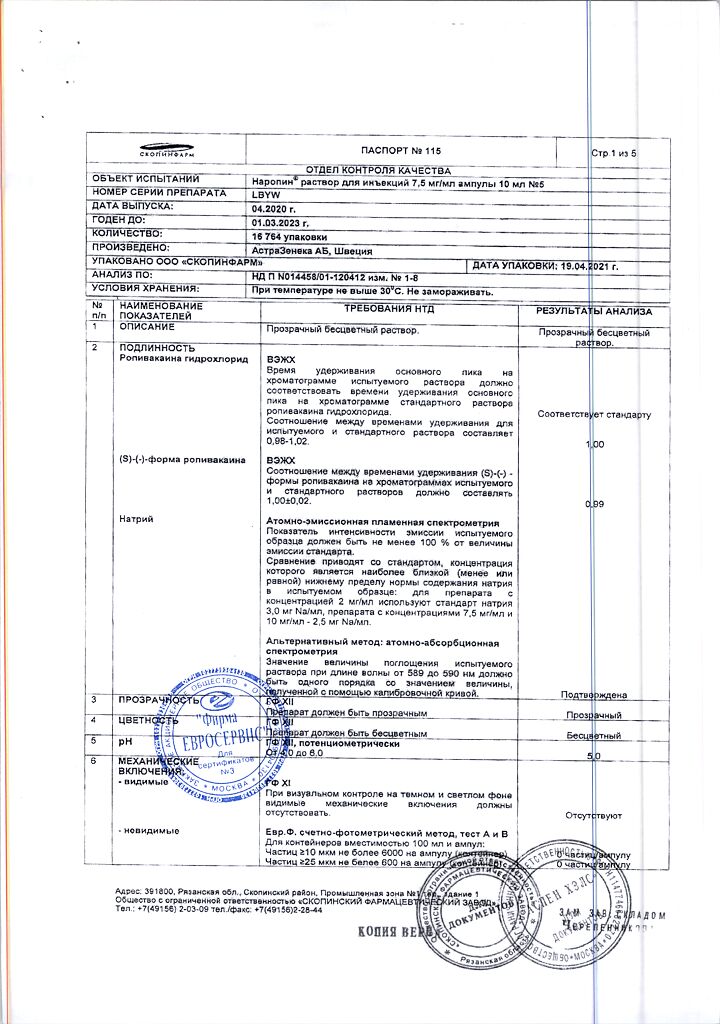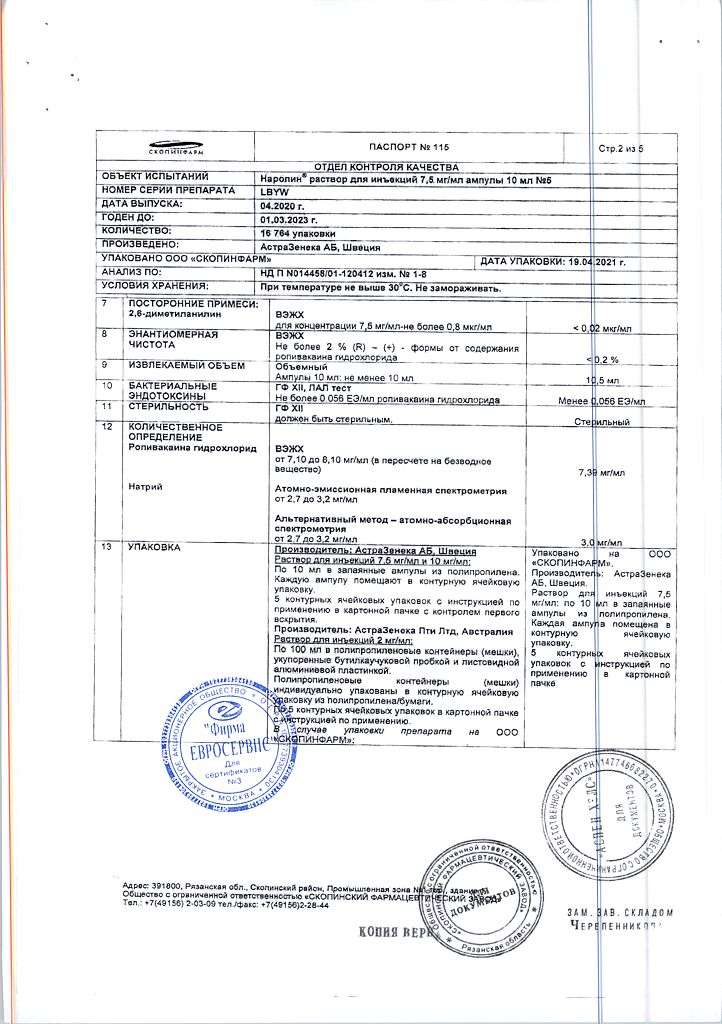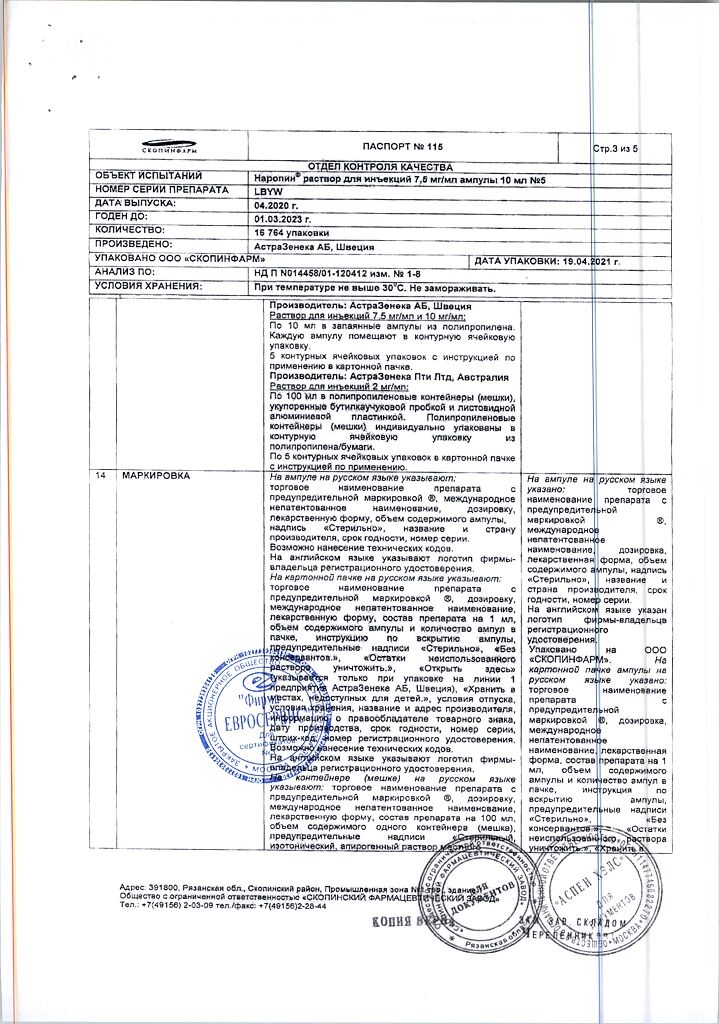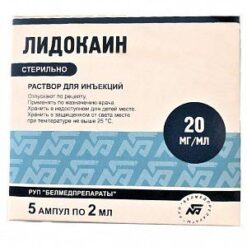No products in the cart.
Naropin, 7.5 mg/ml 10 ml 5 pcs
€1.00
Out of stock
(E-mail when Stock is available)
EAN: 7321838730741
SKU: 125051
Categories: Anesthesia and resuscitation, Anesthesia solutions, Medicine
Description
A long-acting local anesthetic of the amide type. It reversibly blocks voltage-dependent sodium channels and thus prevents generation of impulses in the endings of sensitive nerves and conduction of impulses along the nerve fibers.
The duration of action depends on the route of administration and the dose of the drug.
Pharmacokinetics
Absorption
After administration, ropivacaine is completely absorbed from the epidural space. Absorption is biphasic. Plasma concentration of ropivacaine depends on the dose, route of administration and vascularization of the injection area. Pharmacokinetics of ropivacaine is linear, Cmax is proportional to the administered dose.
Distribution
The pKa of ropivacaine is 8.1; the distribution coefficient is 141 (n-octanol/phosphate buffer pH 7.4).
Vd is 47 l. The average hepatic extraction rate obtained in the experiment is 0.4. Ropivacaine binds in plasma mainly to α1-acid glycoproteins, the unbound fraction is about 6%.
Long-term epidural administration of ropivacaine leads to an increase in total plasma content of ropivacaine, which is due to a postoperative increase in blood levels of α1-acid glycoproteins. However, the concentration of the unbound, pharmacologically active form of ropivacaine in plasma changes to a much lesser extent than the total concentration.
Ropivacaine passes well through the placental barrier. Binding to plasma proteins is lower in the fetus than in the mother.
Metabolism
The drug is actively biotransformed in the body, mainly by hydroxylation. The main metabolite is 3-hydroxy-ropivacaine.
The T1/2 is biphasic and is 14 min (α-phase) and 4 h (β-phase). Total plasma clearance is 440 ml/min. After IV administration about 86% of the dose is excreted with the urine, mainly as metabolites, and only about 1% of the dose is excreted unchanged with the urine. About 37% of 3-hydroxy-ropivacaine is excreted with the urine mainly in the conjugated form.
Indications
Indications
Anesthesia for surgical interventions:
epidural block during surgical interventions, including caesarean section;
blockade of large nerves and nerve plexuses;
block of individual nerves and local infiltration anesthesia.
Relief of acute pain syndrome:
long-term epidural infusion or intermittent bolus administration, for example to eliminate postoperative pain or pain relief during labor;
block of individual nerves and local infiltration anesthesia.
Pharmacological effect
Pharmacological effect
Pharmacotherapeutic group: Local anesthetic
Pharmacological action
Long-acting amide-type local anesthetic. Reversibly blocks voltage-dependent sodium channels and thus prevents the generation of impulses at the endings of sensory nerves and the conduction of impulses along nerve fibers.
The duration of action depends on the route of administration and dose of the drug.
Pharmacokinetics
Suction
After administration, ropivacaine is completely absorbed from the epidural space. Absorption is biphasic. The plasma concentration of ropivacaine depends on the dose, route of administration and vascularization of the injection site. The pharmacokinetics of ropivacaine is linear, Cmax is proportional to the administered dose.
Distribution
pKa of ropivacaine is 8.1; distribution coefficient – 141 (n-octanol/phosphate buffer pH 7.4).
Vd is 47 l. The average hepatic extraction rate obtained in the experiment was 0.4. Ropivacaine binds in blood plasma mainly to α1-acid glycoproteins, the unbound fraction is about 6%.
Long-term epidural administration of ropivacaine leads to an increase in the total content of ropivacaine in the blood plasma, which is due to a postoperative increase in the level of α1-acid glycoproteins in the blood. In this case, the concentration of the unbound, pharmacologically active form of ropivacaine in the blood plasma changes to a much lesser extent than the total concentration.
Ropivacaine passes well through the placental barrier. Plasma protein binding is lower in the fetus than in the mother.
Metabolism
It is actively biotransformed in the body, mainly through hydroxylation. The main metabolite is 3-hydroxy-ropivacaine.
Removal
T1/2 is biphasic and is 14 minutes (α-phase) and 4 hours (β-phase). Total plasma clearance – 440 ml/min. After IV administration, about 86% of the dose is excreted in the urine, mainly in the form of metabolites, and only about 1% of the dose is excreted unchanged in the urine. About 37% of 3-hydroxy-ropivacaine is excreted in the urine, mainly in conjugated form.
Special instructions
Special instructions
The regional anesthesia procedure should be performed by experienced specialists. Availability of equipment and medications for resuscitation measures is mandatory. IV catheters must be installed before major blockades are performed.
The drug should be administered with caution to patients with severe concomitant diseases (including partial or complete heart block, progressive liver cirrhosis, significant renal impairment). To reduce the risk of developing severe side effects, it is necessary to pre-treat concomitant diseases before performing large blockades, as well as adjust the dose of anesthetic used. In patients with severe liver disease, the drug should be used with caution; in some cases, due to impaired elimination, it may be necessary to reduce doses with repeated administrations of the drug. Typically, in patients with impaired renal function, a single dose of the drug or short-term infusion does not require dose adjustment. However, acidosis and a decrease in plasma protein concentrations, which often develop in patients with chronic renal failure, may increase the risk of systemic toxic effects of the drug. In such cases, the dose of the drug should be reduced.
Use in pediatrics
It is not recommended to use Naropin in children under 12 years of age due to the lack of sufficient clinical observations.
Impact on the ability to drive vehicles and machinery
The use of Naropin can lead to temporary impairment of motor functions, coordination of movements and speed of psychomotor reactions.
The period of time after which you can engage in potentially hazardous activities that require increased attention is set individually.
Active ingredient
Active ingredient
Ropivacaine
Composition
Composition
Active substance: ropivacaine
Excipients: sodium chloride, hydrochloric acid or sodium hydroxide (up to pH 4-6), water for injection.
Pregnancy
Pregnancy
Naropin can be used during pregnancy only if justified by the clinical situation. However, in obstetrics, the use of the drug for anesthesia or analgesia is well justified.
Ropivacaine can pass into breast milk in small quantities, which should be taken into account if it is necessary to use the drug during lactation (breastfeeding).
Contraindications
Contraindications
hypersensitivity to the components of the drug;
known hypersensitivity to amide-type local anesthetics.
With caution: the drug should be administered to weakened elderly patients or patients with severe concomitant diseases, such as second and third degree intracardiac conduction blocks (sinoatrial, atrioventricular, intraventricular), progressive liver diseases, severe liver failure, severe chronic renal failure, during the treatment of hypovolemic shock. For these patient groups, regional anesthesia is often preferred. When performing “major” blockades, in order to reduce the risk of severe adverse events, it is recommended to first optimize the patient’s condition, as well as adjust the dose of the anesthetic.
Caution should be exercised when injecting local anesthetics into the head and neck area due to the possible increased incidence of serious side effects.
When administering the drug intra-articularly, caution should be exercised if there is a suspicion of recent extensive joint trauma or surgery with exposure of large joint surfaces due to the possibility of increased absorption of the drug and a higher concentration of the drug in the plasma.
Particular attention should be paid when using the drug in children under 6 months due to the immaturity of organs and functions.
Patients on a sodium-restricted diet should take into account the sodium content of the drug.
Side Effects
Side Effects
Adverse reactions to Naropin® are similar to reactions to other amide-type local anesthetics. These should be distinguished from physiological effects resulting from sympathetic nerve blockade during epidural anesthesia, such as decreased blood pressure, bradycardia, or effects related to the injection technique, such as local nerve injury, meningitis, post-dural puncture headache, and epidural abscess.
Side effects associated with local anesthetics
From the central and peripheral nervous system
Neuropathy and dysfunction of the spinal cord are possible (anterior spinal artery syndrome, arachnoiditis, cauda equina syndrome), usually associated with the technique of regional anesthesia, and not with the effect of the drug.
Complete spinal block may occur as a result of accidental intrathecal administration of an epidural dose.
Serious complications are possible with systemic overdose and unintentional intravascular administration of the drug (see section “Overdose”).
Acute systemic toxicity
Naropin can cause acute systemic toxic reactions when using high doses or when its concentration in the blood rapidly increases due to accidental intravascular administration of the drug or its overdose (see section “Overdose”).
Most common side effects
Various side effects of the drug have been reported, the vast majority of which were related not to the effects of the anesthetic used, but to the technique of regional anesthesia.
The most common (>1%) side effects were the following, which were considered to be of clinical significance, regardless of whether a cause-and-effect relationship with the use of the anesthetic was established: decreased blood pressure*, nausea, bradycardia, vomiting, paresthesia, increased body temperature, headache, urinary retention, dizziness, chills, increased blood pressure, tachycardia, hypoesthesia, anxiety.
Very often
From the cardiovascular system: decreased blood pressure.
From the gastrointestinal tract: nausea.
Often
From the nervous system: paresthesia, dizziness, headache.
From the cardiovascular system: bradycardia, tachycardia, hypertension.
From the gastrointestinal tract: vomiting.
From the genitourinary system: urinary retention.
General: back pain, chills, increased body temperature.
Uncommon
From the nervous system: anxiety, symptoms of toxicity from the central nervous system (convulsions, grand mal seizures, paresthesia in the perioral area, dysarthria, numbness of the tongue, visual disturbances, tinnitus, tremor, muscle cramps), hypoesthesia.
From the vascular system: fainting.
From the respiratory system: shortness of breath, difficulty breathing.
General: hypothermia.
Rarely
From the cardiovascular system: arrhythmia, cardiac arrest.
General: allergic reactions (anaphylactic reactions, angioedema, urticaria).
Interaction
Interaction
When Naropin is used simultaneously with other local anesthetics or drugs structurally similar to amide-type local anesthetics, the toxic effects may be additive.
Pharmaceutical interaction
Increasing the pH of the solution above 6.0 may lead to the formation of a precipitate due to the poor solubility of ropivacaine under these conditions.
Overdose
Overdose
Symptoms: Accidental intravascular injection of an anesthetic may cause symptoms of intoxication that appear immediately or over a delayed period.
The entry of excess amounts of the drug into the systemic bloodstream has a depressing effect on the central nervous system and myocardium (reduces excitability and automaticity, impairs conductivity).
Neurological manifestations are discrete in nature. First, visual and hearing disturbances, dysarthria, increased muscle tone, and muscle twitching appear. As intoxication progresses, loss of consciousness and attacks of convulsions lasting from several seconds to several minutes are possible, which is accompanied by the rapid development of hypoxia and hypercapnia and respiratory failure, even stopping in severe cases. Respiratory and metabolic acidosis potentiate the toxic effects of the anesthetic.
Subsequently, due to the redistribution of the anesthetic from the central nervous system and its subsequent metabolism and excretion, functional restoration occurs, which can occur quite quickly unless the drug was administered in a high dose.
Cardiovascular dysfunction in the form of arterial hypotension and arrhythmia usually follows the initial manifestations of neurological disorders, unless the patient is under general anesthesia or has not been premedicated with benzodiazepines or barbiturates.
Treatment: when the first signs of systemic intoxication appear, the drug should be stopped immediately. During seizures, adequate oxygen supply should be maintained using a bag or mask. If after 15-20 seconds the convulsions do not stop, anticonvulsants should be used (IV 100-120 mg of thiopental or 5-10 mg of diazepam; after intubation and the start of mechanical ventilation, suxamethonium can be administered). If the activity of the cardiovascular system is suppressed (arterial hypotension, bradycardia), it is necessary to administer ephedrine intravenously at a dose of 5-10 mg, if necessary, repeat the administration after 2-3 minutes. In the event of cardiac arrest, standard resuscitation measures should be carried out. It is necessary to maintain optimal blood gas composition while simultaneously correcting acidosis.
Storage conditions
Storage conditions
Below 30°C (do not freeze)
Shelf life
Shelf life
3 years
Manufacturer
Manufacturer
AstraZeneca AB, Sweden
Additional information
| Shelf life | 3 years |
|---|---|
| Conditions of storage | At temperatures below 30 °C (do not freeze) |
| Manufacturer | AstraZeneca AB, Sweden |
| Medication form | solution for injection |
| Brand | AstraZeneca AB |
Related products
Buy Naropin, 7.5 mg/ml 10 ml 5 pcs with delivery to USA, UK, Europe and over 120 other countries.










